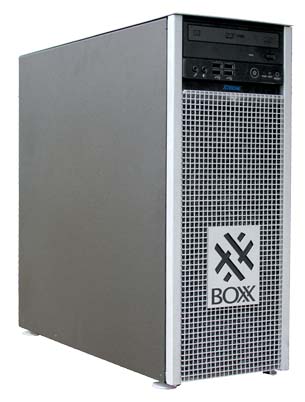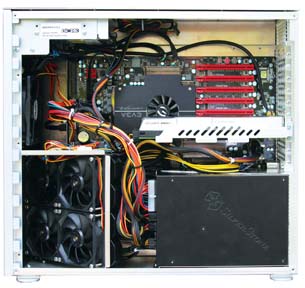Review: The 3DBOXX 8550 XTREME
This dual-CPU system from BOXX Technologies is the fastest (and the most expensive) we've tested.
Latest News
December 4, 2001
By David Cohn
 The 3DBOXX 8550 XTREME workstation from BOXX Technologies houses a pair of over-clocked Intel Xeon six-core CPUs. It is the fastest system we’ve tested to date. |
In the January issue, we reviewed a powerful workstation from Austin-based BOXX Technologies. At that time, the 3DBOXX 4860 Extreme, equipped with a single over-clocked six-core Intel i7 CPU, outperformed every system we had tested to date.
Not willing to rest on its laurels, however, BOXX sent us another system: its 3DBOXX 8550 XTREME, equipped with a pair of over-clocked Intel Xeon W5680 six-core CPUs. To say that this system outperformed the company’s previous system would be a serious understatement. The 3DBOXX 8550 XTREME blew the doors off.
If you missed that earlier review, BOXX Technologies has been building high-performance systems since 1996, but targets most of its workstations toward digital content creation and visual effects. However, its workstations have also found homes among higher-end CAD and engineering users, and its systems are certified by numerous ISVs, including Autodesk and SolidWorks.
Cramped Interior
Once we opened the 3DBOXX 8550 XTREME, we immediately noted lots more differences between this and the previous 3DBOXX workstation. Where the earlier system had a roomy interior, the 8550 XTREME was extremely cramped. A cage with four cooling fans for the liquid cooling system filled the lower front quarter of the case, with the large, 1,500-watt Silverstone Strider ST1500 power supply filling the remaining bottom portion of the chassis.
The 3DBOXX 8550 XTREME is built around a Classified Super Record 2 (SR-2) motherboard manufactured by EVGA and based on the Intel 5520 and ICH10R chipset, as well as the NVIDIA NF200 chipset. This enables the system to provide more PCIe lanes, and results in a system capable of supporting up to seven single-slot graphics cards or four dual slot GPUs. The motherboard also provides a dozen 240-pin DIMM sockets, arranged around the pair of CPUs as two banks of six sockets each. The board supports up to 48GB of memory and has six SATA II connectors.
Unfortunately, the high-performance technology extended (HPTX) motherboard, which measures 15x13.6 in., extends beneath both the power supply and cooling system. As a result, both the CPUs and memory sockets are concealed beneath the power supply and cooling fans.
| Benchmark Comparison Results |
Our evaluation unit came equipped with 24GB of memory, installed as a dozen 2GB DDR3-1333MHz ECC memory modules, thus filling all 12 sockets. A BOXX representative told us that customers who want to add memory themselves can do so by loosening two screws and removing the power supply, although they can also simply send the system back to BOXX and let tech support do the work.
Happily, the hard drive connectors remained totally accessible, so we could have easily installed additional storage. Like the 3DBOXX 4860, the hard drive cage is actually the metal back plane behind the motherboard. Removing the side panel on the left side of the system reveals this space. There, we found a single 300GB Western Digital 10,000rpm SATA drive. The cage actually provides mounting locations for up to 12 drives, which attach easily using four Phillips head screws.
Several additional sets of data and power cables were already in place to support more hard drives, and BOXX included lots of additional cables and hardware should customers want to install even more. BOXX offers hard drives of up to 600GB capacity, as well as redundant array of independent disks (RAID) and solid-state drives. As we noted in January, however, while this is a novel spot to mount the drives, they’re likely to get just a fraction of the air flowing through the case.
 The power supply and fans for the liquid cooling system block access to the CPU and memory sockets. But there’s plenty of expansion, thanks to seven PCIe slots. |
Twelve Over-Clocked Cores
Our 3DBOXX 8550 XTREME came with a pair of 3.33GHz Intel Xeon processors, each providing six CPU cores. BOXX then ups the ante by over-clocking the CPUs to 4.2GHz. Given that the processors also support hyper-threading, we had the equivalent of 24 CPU cores.
Since receiving our evaluation unit, BOXX has raised the bar yet again: The latest 8550 XTREME systems, which remain priced the same as the one we received, now come with the Intel Xeon W5690 CPU, which BOXX tweaks just a bit further to 4.3GHz.
Our evaluation unit also came with the same NVIDIA Quadro 5000 graphics board we found in the previous BOXX system as well as the Dell T5500 that we recently reviewed (DE March 2011). The Quadro 5000 is built on NVIDIA’s latest Fermi architecture, with 352 CUDA cores and 2.5GB of GDDR5 video memory. That graphics board was installed in one of the PCIe x16 slots.
The motherboard provides a total of seven PCIe slots, but no legacy PCI slots. Four of those slots are x16, while the ones between them are x8. This enables the motherboard to support up to four boards the thickness of the Quadro 5000.
BOXX offers other graphics accelerators from both ATI and NVIDIA, ranging from the Quadro 600 and Fire Pro V4800, to the ultra-high-end Fire Pro V9800 and Quadro 6000.
Fastest Performance Ever
Because the 3DBOXX 8550 XTREME was similar to the Dell T5500 (the significant differences being the CPU over-clocking and amount of memory), we were curious to see how the performance would stack up. The extra CPU speed proved to be the deciding factor. On the SPECviewperf test, which focuses solely on graphics performance, the 3DBOXX 8550 XTREME outperformed every other system on all but two of the datasets.
| BOXX 3DBOXX 8550 XTREME • Price: $11,396 as tested ($8,317 base price) System Requirements • Size: 7x19.5x17.5 in. (WxDxH, w/handle) tower • Weight: 32 lbs. • CPU: two Intel Xeon W5680 (six-core) 3.33GHz (over-clocked to 4.2GHz) • Memory: 24GB DDR3 ECC at 1333MHz (up to 48GB supported) • Graphics: NVIDIA Quadro 5000 • Hard Disk: Western Digital 300GB SATA 10,000rpm drive • Optical: Pioneer 24X DVD+/-RW Dual-Layer • Audio: onboard integrated high-definition audio (microphone and headphone on front panel; microphone, line-in, front, center/subwoofer, side and rear speakers on rear panel) • Network: integrated 10/100/1000 LAN with two RJ45 sockets |
This time around, BOXX provided a dual-boot system, so we could perform our tests under both Windows 7 Ultimate 64-bit and Windows XP 64-bit. This enabled us to run the full SolidWorks benchmark, which is more of a real-world test and additionally breaks out graphics, CPU and I/O performance separately from the overall scores. Once again, the 3DBOXX 8550 XTREME beat every system we’ve tested to date.
When we turned our attention to our own AutoCAD rendering test, which clearly shows the advantages of hyper-threading, the 3DBOXX 8550 XTREME absolutely astonished us, completing the rendering in just 19 seconds. Less than a year ago, most systems took two minutes or more to complete this test.
Of course, if you’re going to over-clock a CPU, you’d better provide lots of cooling. The liquid cooling system has four dedicated fans. There’s also a separate fan on the front panel, one in the NVIDIA graphics board, one in the power supply and one on the motherboard itself. We definitely knew when this system was running—but the fan noise was not overly intrusive and would likely fade into the background in a busy office.
BOXX rounded out the system with a Logitech K120 104-key keyboard and a Logitech LX3 optical mouse. In addition to Windows 7, SUSE and Red Hat Linux are also available. BOXX Technologies backs the system with a three-year warranty, and phone and email tech support are available Monday through Friday from 7 a.m. to 6 p.m. CST.
Needless to say, this much power comes with a hefty price tag. The 3DBOXX 8550 XTREME carries a base cost of $8,317, which gets you two CPUs, 6GB of RAM, an NVIDIA Quadro 600 graphics board and a 160GB 7,200rpm SATA hard drive, plus the optical drive, OS, keyboard and mouse. Adding the extra memory (+$999), high-end Quadro 5000 graphics board (+$1,816), and 300GB hard drive (+$264) increased the total price to $11,396, making the 3DBOXX 8550 XTREME not only the fastest system we’ve ever tested, but also the most expensive. That price will surely place this system beyond the reach of many, but for those who need the absolute fastest performance available, coupled with support for up to four dual-slot GPUs, the 3DBOXX 8550 XTREME is now the one to beat.
More Info:
BOXX Technologies, Inc.
David Cohn is the technical publishing manager at 4D Technologies. He’s a contributing editor to Desktop Engineering and also does consulting and technical writing from his home in Bellingham, WA. The author of more than a dozen books has been benchmarking PCs since 1984. You can contact him via email at [email protected] or visit DSCohn.com.
Subscribe to our FREE magazine, FREE email newsletters or both!
Latest News
About the Author
David Cohn is a consultant and technical writer based in Bellingham, WA, and has been benchmarking PCs since 1984. He is a Contributing Editor to Digital Engineering, the former senior content manager at 4D Technologies, and the author of more than a dozen books. Email at [email protected] or visit his website at www.dscohn.com.
Follow DE





